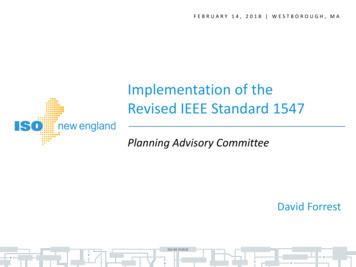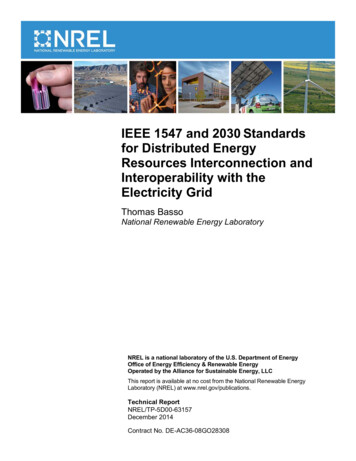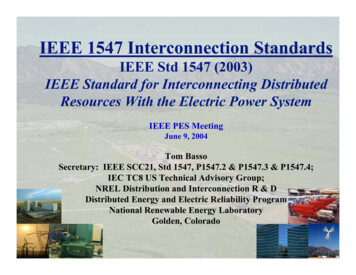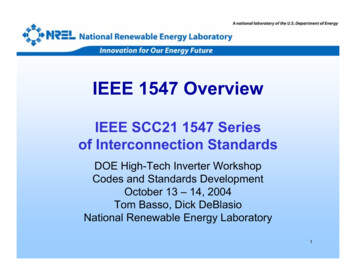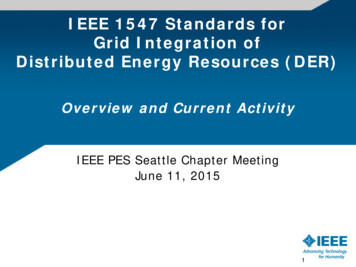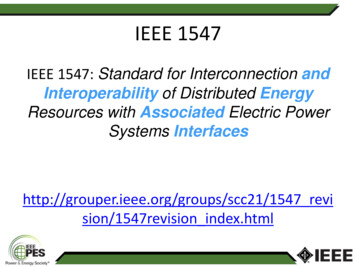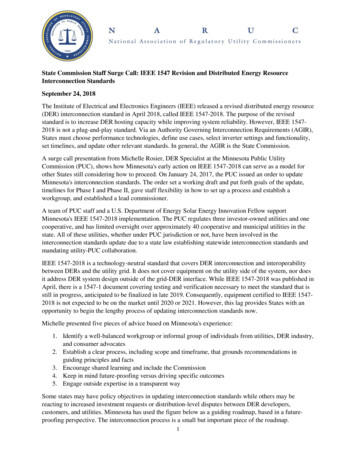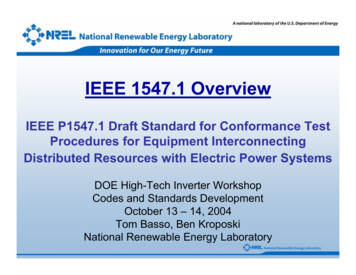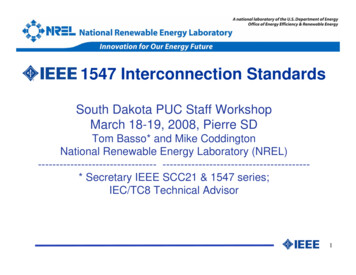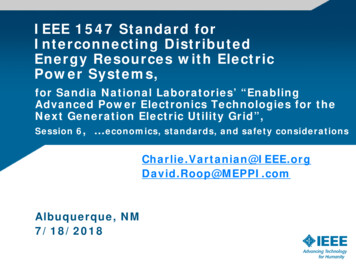
Transcription
IEEE 1547 Standard forInterconnecting DistributedEnergy Resources with ElectricPower Systems,for Sandia National Laboratories’ “EnablingAdvanced Power Electronics Technologies for theNext Generation Electric Utility Grid”,Session 6, economics, standards, and safety @MEPPI.comAlbuquerque, NM7/18/2018
Disclaimer This presentation on IEEE 1547-2018 arethe author’s views and are not the formalposition, explanation or position of theIEEE or MEPPIThe author acknowledges the contributionof the IEEE 1547-2018 Working Group andOfficers2
Panel Presentation Outline1) IEEE 1547 Background2) Revised 1547 & Overcoming Integration Challenges3) Two examples of future advanced power techenabling ES applications and improved economics33
IEEE 1547 Uses A technical standard—functional requirements for theinterconnection itself and interconnection testing A single (whole) document of mandatory, uniform,universal, requirements that apply at the point ofcommon coupling (PCC) or point of DER connection(PoC) Technology neutral—i.e., it does not specify particularequipment or type Should be sufficient for most installations A design handbook An application guide (see IEEE 1547.2) An interconnection agreement Prescriptive—i.e., it does not prescribe other importantfunctions and requirements such as cyber-physicalsecurity, planning, designing, operating, or maintainingthe area EPS with DERIEEE 1547 is:IEEE 1547 isnot:4
Importance of IEEE 1547 Energy Policy Act (2005) Cites and requires consideration of IEEE 1547 Standards andBest Practices for Interconnection; all states use or cite 1547. Energy Independence and Security Act (2007) IEEE cited as a standards developmentorganization partner to NIST as Lead to coordinate framework and roadmap for Smart GridInteroperability standards and protocols {IEEE 1547 & 2030 series being expanded}; Adoption by the majority of jurisdictional entities across N. America that set DERinterconnection rules55
6IEEE 1547 Scope and PurposeTitle: Standard for Interconnection and Interoperability of Distributed Energy Resources with AssociatedElectric Power Systems InterfacesScope: This standard establishes criteria and requirements for interconnection of distributed energyresources (DER) with electric power systems (EPS), and associated interfaces.Interconnection SystemDistributedEnergyResource(DER)Communications interfacePower interfacePurpose: This document provides a uniform standard forthe interconnection and interoperability of distributed energyresources (DER) with electric power systems (EPS). Itprovides requirements relevant to the interconnection andinteroperability performance, operation, and testing, and,safety, maintenance and security considerations.Image based on IEEE 1547-2018ElectricPowerSystem(Area EPS)Interconnection system: The collection of allinterconnection equipment and functions, taken asa group, used to interconnect DERs to an areaEPS. Note: In addition to the power interface,DERs should have a communications interface.Interface: A logical interconnection from one entityto another that supports one or more data flowsimplemented with one or more data links.6
IEEE 1547 Evolution of Grid SupportFunctionsIEEE 15472003 Shall NOT actively regulate voltageShall trip on abnormal voltage/frequency2014 May actively regulate voltageMay ride through abnormal voltage/frequencyMay provide frequency response1 (frequency-droop)IEEE 15472018 Shall be capable of actively regulating voltageShall ride through abnormal voltage/frequencyShall be capable of frequency response2May provide inertial response3IEEE 1547a(Amendment 1)1Frequencyresponse is capability to modulate power output as a function of frequencycapability for Categories II and III under high frequency conditions, Mandatory for Categories II and IIIunder low frequency conditions, optional for Category 13Inertial response is capability for DER to modulate active power in proportion to the rate of change of frequency2Mandatory7
Evolving Standards Support Accessing DER’s Value StackES Applications – from CA AB2514,1547-2003 vs. new CA 21 &1547RevisionSource(table): CPUC Staff, AB2514 workshop, 3/25/20138
Improve Transmission Asset Utilizationby Lifting Stability Limit Constraint,with Synthetic InertiaConstraint:Loss of system inertia reduces theamount of power that can beimported into a stability-limited loadpocket.Solution:Add synthetic inertia functionality toBESS’s located in the load pocket toincrease total system stability.Comments:Project scale is 50-250 MW, buteffective capacity is multiples ofnameplate capacity.Appropriate BESS capacity withsynthetic inertia functionality can alsocontribute to meeting NERCFrequency Responsive Reservescompliance requirement.9- Load Center250 MW Nameplate1000 MW Effective- 250 MW Nameplate1000 MW EffectiveSiC with short term OL, used w/ ES,has 4X benefit per MVA installed.Leverages new FRR requirements!COPYRIGHT MITSUBISHI ELECTRIC CORPORATION. ALL RIGHTS MISSIONNONOPARTSHALLBE BECOPIEDORORTRANSFERREDWITHOUTPRIORPERMISSION.
Future, FACTS-based Grid Interface230 kV56 MVA1 X 56 MVA13.8 kV3 building-housed battery strings,Or very large PV array(60MWdc total) 20 MWdc, MVdc1 VSC-MMC FACTS system20 MWdc, MVdc 20 MWdc, 20 MVdcAssumed base battery scope is one series-parallel (S-P)string. Rated 20 MWdc, 20 kVdc at 100% State of Charge.15 second to 4-hr discharge duration depending on theapplications delivered. 4-hr discharge needed for some firmcapacity applications.6 Med. V DC cable or bus runsNo LV/MV XFMR’sNo Low V DC cable runsProject footprint,125,000 sq ft.2.9 acres,17% reduction in land used,per 50 MW ‘module’10COPYRIGHT MITSUBISHI ELECTRIC CORPORATION. ALL RIGHTS MISSIONNONOPARTSHALLBE BECOPIEDORORTRANSFERREDWITHOUTPRIORPERMISSION.
547 dard/1547-2018.html
Aug 06, 2018 · IEEE 1547 is: IEEE 1547 is not: A design handbook An application guide (see IEEE 1547.2) An interconnection agreement Prescriptive—i.e., it does not prescribe other important functions and requirements such as cyber-physical security, planning, d
